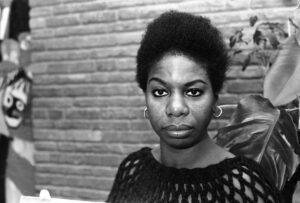 Nina Simone is a fairly recent arrival in my music collection, though I had known her name, and at least a little bit about her music, for years before. For much of that time, she was one of those figures from just before my time or just outside my musical spheres of influence, like Wanda Jackson or Billie Holiday, who I figured I would learn more about someday. I vaguely recall tributes following her death in 2003, providing me with a hazy image of her as a bad-ass Black woman who was around in the 1960s. Sometime since then, her song “Mississippi Goddam” entered my consciousness, though whether it was because Mississippi was in the news again for doing something awful or because I was watching something about the civil rights movement, I no longer remember.
Nina Simone is a fairly recent arrival in my music collection, though I had known her name, and at least a little bit about her music, for years before. For much of that time, she was one of those figures from just before my time or just outside my musical spheres of influence, like Wanda Jackson or Billie Holiday, who I figured I would learn more about someday. I vaguely recall tributes following her death in 2003, providing me with a hazy image of her as a bad-ass Black woman who was around in the 1960s. Sometime since then, her song “Mississippi Goddam” entered my consciousness, though whether it was because Mississippi was in the news again for doing something awful or because I was watching something about the civil rights movement, I no longer remember.
I do clearly remember when Questlove’s documentary about the 1969 Harlem Cultural Festival, “Summer of Soul,” came out a couple of years back. And I looked at the artist list and thought, “Okay, I’m finally going to get educated about Nina Simone.”
I had known that Simone was seen as a great singer and great activist, but I had no idea until seeing her performance from 1969 that she was such a force: Fixing her eyes on the crowd, crashing on the piano keys, schooling the audience about Lorraine Hansberry, absolutely grabbing the moment by the throat. Watching her too-brief appearance in the documentary — if ever there’s a movie that calls for an expanded edition, or just an expanded soundtrack release, it’s this one — you can’t look away, and it makes you think that music, and the world, can be something completely different.
At the same time, I am not precisely the ideal target audience for Nina Simone. Much of her music is in the wide expanse between jazz and blues, and there are only a few odd corners of jazz that I enjoy. And while I appreciate messages of Black empowerment plenty, that’s still different from being Black; when Charlayne Hunter-Gault tells Questlove that Nina Simone’s records got her through the racism she faced as one of the first two African American students at the University of Georgia, it’s not a relationship to the music that I can ever hope to fully appreciate.
Not long after watching the documentary, I found myself at Amoeba Records in San Francisco, which is one of my go-to places for grabbing up music I’ve waited too long to check out. (The other main one, needless to say, is the WFMU record fair.) I came away that day with, amid my stack of new purchases, a pair of CD reissues encompassing four mid-’60s Simone albums: In Concert, I Put a Spell on You, Pastel Blues, and Let It All Out. They’re good, if very geared toward a certain kind of audience — her version of “Sinnerman” is rightly viewed as a classic, but as someone who was introduced to it by the later Peter Tosh renditions, I can’t say that my favorite is one that features an upright bass solo. And none of the four albums managed to grab me quite like her performance in the Harlem festival movie did; there’s a difference between appreciating and being transfixed.
Nina Simone is probably going to be one of those artists who I respect the hell out, but who I don’t listen to that much, and that’s okay. There are other people who are following in her footsteps, or expanding on them with some of the same power — Rhiannon Giddens and Amythyst Kiah come to mind — who are more my speed. I’m still hoping to one day find the right Simone album that captures what the excerpts of her performance in Harlem did, but it’s entirely possible that I never will; it was a moment, and it was for the people there, and that’s enough.